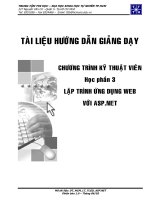Tài liệu giảng dạy CCNA - module 06 chapter 21-ISDN and Dial-on-Demand Routing
Bạn đang xem bản rút gọn của tài liệu. Xem và tải ngay bản đầy đủ của tài liệu tại đây (458.88 KB, 32 trang )
1
Module 06 WAN
Technology
Chapter 21
ISDN and Dial-on-Demand Routing
2
Objectives
Upon completion of this chapter, you will be able to
perform the following tasks:
•
Describe the components that make up ISDN
connectivity
•
Configure ISDN BRI and legacy dial-on-demand
routing (DDR)
•
Verify DDR operation
3
What is ISDN?
Provider
network
Digital
PBX
Small office
Home office
Voice, data, video, and special services
Telecommuter
Central site
4
Standards from the ITU (formerly CCITT)
ISDN Standards
Protocol Key Examples
Telephone
Network and
ISDN
ISDN Concepts,
Aspects, and
Interfaces
Switching and
Signaling
I-Series
Q.921—LAPD (Link Access Procedure
on the D channel)
Q.931—ISDN Network Layer between
Terminal and Switch
Q-Series
Issue
E-Series
E.163—International Telephone
Numbering Plan
E.164—International ISDN Addressing
I.100 Series—Concepts, Structures,
Terminology
I.400—User-Network Interfaces (UNIs)
5
•
BRI and PRI are used globally for ISDN
Channel Mostly Used for
B
Circuit-switched data (HDLC, PPP)
Capacity
64 kbps
D 2B
Service
provider
network
NT1
ISDN Access Options
Signaling information (LAPD)
D 16/64 kbps
CSU/DSU
23 or 30B
BRI
PRI
D
6
3
3
1
1
BRI Call Processing
ISDN
service provider
4
4
B channel(s)
D channel/SS7 signaling
2
2
SS7
ISDN
Switch
ISDN
Switch
7
ISDN Functions and Reference
Points
•
Functions are devices or
hardware
•
Reference points are
demarcations or interfaces
NT1
TA
TE2
TE1
NT2
Local
loop
Existing
Terminal
ISDN Terminal
Terminal
Adapter
R
S
T
U
Service
provider
network
8
Cisco ISDN BRI Interfaces
TA
S/T
R
Service
provider
network
Native ISDN interface—int bri 0
Nonnative ISDN interface—int serial 0
(EIA/TIA-232, V.35, X.21)
NT1
NT1
S0
S/T
bri 0
U
bri 0
TE1
NT1
TE1
TE2
9
•
Many providers and switch types
•
Services vary by regions and countries
ISDN Switch Types
CO CO
S
S
S
S S
S S
S S
S
S
S
S
10
Router(config)#isdn switch-type switch-type
Configuring ISDN BRI
•
Specifies the type of ISDN switch with
which the router communicates
•
Other configuration requirements vary for specific providers
Step 1: Specify the ISDN switch type
Router(config-if)#isdn switch-type switch-type
11
•
Sets a B channel SPID required by many service
providers
Configuring ISDN BRI (cont.)
Step 2: (Optional) Setting SPIDs
•
Sets a SPID for the second B channel
Router(config-if)#isdn spid1 spid-number [ ldn ]
Router(config-if)#isdn spid2 spid-number [ ldn ]
12
Written Exercise
Local LoopCustomer Premises Service Provider
BRI 0
S 0
Label the functional elements and reference points
13
Written Exercise: Answers
Local LoopCustomer Premises Service Provider
NT1
BRI 0
S 0
NT1
TA
U
U
S/T
S/T
R
Label the functional elements and reference points
14
What Is Dial-on-Demand Routing?
PSTN
ISDN
I need to send
data to Dallas.
Dallas
Corporate
Chicago
•
Connect when needed
•
Disconnect when finished
•
ISDN or PSTN
15
When to Use DDR
Headquarters
Telecommuter
Vendor
•
Periodic connections
•
Small amounts of data
16
Generic DDR Operation
1. Route to destination is determined
DCE
“Interesting”
packet arrives
17
Generic DDR Operation
1. Route to destination is determined
2. Interesting packets dictate DDR call
DCE
“Interesting”
packet arrives
18
Generic DDR Operation
1. Route to destination is determined
2. Interesting packets dictate DDR call
3. Dialer information is looked up
“Interesting”
packet arrives
Dial connection
ISDN or
Basic
Service
DCE
19
1. Route to destination is determined
2. Interesting packets dictate DDR call
3. Dialer information is looked up
4. Traffic is transmitted
5. Call is terminated
Generic DDR Operation
“Interesting”
packet arrives
Dial connection
ISDN or
Basic
Service
DCE
20
Configuring Legacy DDR
1
Define static routes—What route do I use?
“Interesting”
packet arrives
DCE
21
Configuring Legacy DDR
1
2
Define static routes—What route do I use?
Specify interesting traffic—What traffic
enables the link?
“Interesting”
packet arrives
DCE
22
3
1
2
Define static routes—What route do I use?
Specify interesting traffic—What traffic
enables the link?
Configure the dialer information—What
number do I call?
Configuring DDR
“Interesting”
packet arrives
Dial connection
ISDN or
Basic
Service
DCE
23
Task 1: Defining Static Routes (Route to
Destination)
Network prefix
and prefix mask
Specify address of
next hop router
ip route 10.40.0.0 255.255.0.0 10.1.0.1
ip route 10.10.0.0 255.255.0.0 10.1.0.2
ip route 10.20.0.0 255.255.0.0 10.1.0.2
Central
ISDN
Home
10.1.0.1
bri 0
5551000
bri 0
5552000
10.1.0.2
Subnets
10.10.0.0
10.20.0.0
Subnet
10.40.0.0
24
Task 2: Specifying Interesting Traffic (What
Enables the Connection?)
dialer-list 1 protocol ip permit
dialer-list 1 protocol ip list 101
access-list 101 deny tcp any any eq ftp
access-list 101 deny tcp any any eq telnet
access-list 101 permit ip any any
Any IP traffic will initiate the link
Any IP traffic, except FTP and Telnet, will initiate the link
Deny FTP
Deny Telnet
•
Without Access Lists
•
With Access Lists (for better control)
25
Task 3: Configuring the Dialer
Information
•
Applies rules defined by
dialer-list to individual
interfaces
hostname Home
!
isdn switch-type basic-5ess
!
username central password cisco
interface BRI0
ip address 10.1.0.1 255.255.255.0
encapsulation ppp
dialer idle-timeout 180
dialer map ip 10.1.0.2 name Central 5552000
dialer-group 1
no fair-queue
ppp authentication chap
!
router rip
network 10.0.0.0
!
no ip classless
ip route 10.10.0.0 255.255.0.0 10.1.0.2
ip route 10.20.0.0 255.255.0.0 10.1.0.2
!
dialer-list 1 protocol ip permit
Both values
must match









